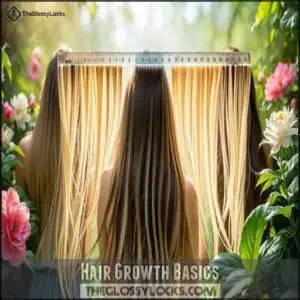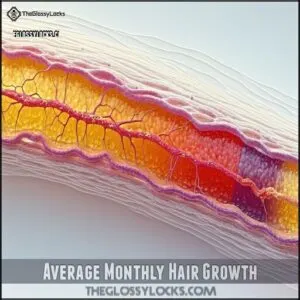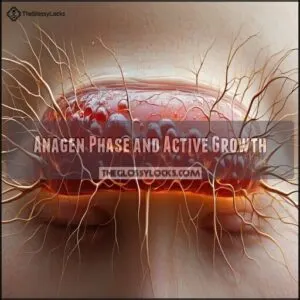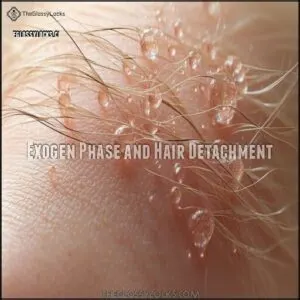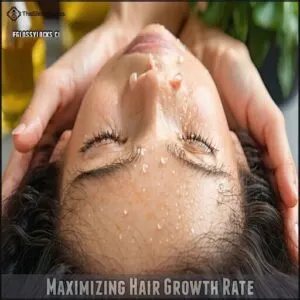This site is supported by our readers. We may earn a commission, at no cost to you, if you purchase through links.
 On average, hair grows about half an inch, or roughly 1.25 centimeters, each month.
On average, hair grows about half an inch, or roughly 1.25 centimeters, each month.
This rate can vary depending on factors like your age, genetics, hormones, and overall health. For instance, someone with a healthy diet rich in proteins and vitamins might see slightly faster growth, while stress or illness could slow things down.
Hair doesn’t grow like clockwork—it follows a cycle with active and resting phases, so patience is key. Think of it as a slow and steady race, not a sprint.
Want to boost your hair’s potential? Nutrition, gentle care, and scalp health can make all the difference.
Table Of Contents
- Key Takeaways
- Hair Growth Basics
- Average Monthly Hair Growth
- Hair Growth Factors
- Hair Growth Cycle Stages
- Maintaining Healthy Hair
- Maximizing Hair Growth Rate
- Frequently Asked Questions (FAQs)
- How fast does hair grow in 1 month?
- How much hair grows in a month?
- How long does it take for hair to grow?
- How do you calculate hair growth in inches per month?
- How long does hair grow on your head a year?
- How long does hair growth last?
- How fast does scalp hair grow?
- What is the difference between curly hair and straight hair?
- How much hair are we born with?
- Why do we get gray hair?
- Conclusion
Key Takeaways
- Hair grows about half an inch per month on average, but genetics, age, and health can make growth faster or slower.
- A balanced diet with protein, vitamins, and hydration helps boost hair’s growth potential and overall health.
- Stress and illness can slow hair growth by disrupting its natural cycle, while gentle styling minimizes breakage and damage.
- Hair goes through a growth cycle with active and resting phases; most hair is in the growing phase lasting 2-7 years.
Hair Growth Basics
Your hair grows at an average rate of half an inch per month, though this can vary based on factors like genetics, age, and overall health.
You’ll find that your individual growth rate falls somewhere between 0.2 and 0.7 inches monthly, with certain ethnicities and hair types showing slight variations from this standard range.
Average Hair Growth Rates
While hair typically grows between 0.5-1.7 centimeters (0.2-0.7 inches) per month, your individual growth rate may surprise you.
Average hair growth varies substantially based on ethnic variations—Caucasian hair grows about 1cm monthly, while Asian hair grows faster at 1.25cm.
Clinical averages often differ from self-measurement accuracy, with growth estimates showing individual variance of up to 20% within each category.
Factors Affecting Hair Growth
While we’ve seen that hair typically grows about half an inch monthly, your genetics influence this rate substantially.
Hormonal changes during pregnancy or menopause can boost or slow your monthly hair growth.
Age effects are natural—growth peaks between 15-30 years then gradually declines.
Medical conditions like thyroid issues or anemia impact your hair’s health, while poor haircare practices (tight styles, heat damage) can limit average hair growth potential, affecting your hair’s overall health.
Hair Growth Cycle
While genetics determine how fast your hair grows, understanding the hair growth cycle reveals why you can’t grow Rapunzel-length locks overnight.
Your hair follicles follow a predictable pattern:
- Anagen phase: The active growth period lasting 3-5 years (determines your maximum hair length)
- Catagen phase: A brief 2-3 week intermediate period
- Telogen phase: The 3-month resting phase with follicle dormancy
- Exogen phase: When telogen shedding naturally occurs
Stress, nutrition, and hormones influence factors affecting shedding, which can impact the hair growth process and overall hair length.
Average Monthly Hair Growth
In terms of average monthly hair growth, you’re looking at about half an inch (1.27 cm) per month for most people.
This hair growth rate isn’t one-size-fits-all, though. Ethnic growth rates show interesting patterns: Caucasian hair typically grows at 1 cm monthly, while Asian hair might sprint ahead at 1.25 cm.
If you’ve been tracking your own growth, you might notice your measurement accuracy varies from clinical findings. Individual variation is significant – your hair might grow anywhere from 0.2 to 0.7 inches monthly.
Some people experience seasonal variation, with faster growth during summer months. To better understand your potential, consider using a hair growth calculator to estimate progress.
Growth expectations should be realistic – if someone promises you’ll grow 2 inches in a month, they’re stretching the truth! How fast hair grows depends on numerous factors, making your monthly growth uniquely yours.
Hair Growth Factors
Your hair’s monthly growth rate isn’t just a random number, but depends on several key factors including genetics, nutrition, hormones, and environmental conditions.
You’ll notice variations in growth speed based on your age, stress levels, overall health, and even the products you’re using on your scalp, which can be influenced by hormones.
Genetics and Hormones Role
Your genetic blueprint and hormone balance work together like master architects of your hair growth rate.
DHT impact varies based on your androgen receptors sensitivity, with some people experiencing hereditary hair loss due to this interaction.
Hormonal imbalances can disrupt your normal growth cycle, while genetic predisposition determines your maximum potential hair growth per month.
The average hair growth rate you experience largely depends on these invisible internal factors rather than external treatments.
Nutrition and Diet Impact
Your plate has a direct impact on your hair’s growth rate. What you eat provides the building blocks for those half-inch monthly gains.
Your diet fuels your hair’s potential—feed it proteins, vitamins, and hydration for stronger, healthier strands.
Here’s how your diet affects hair growth:
- Protein intake fuels follicle function and strand strength
- Vitamins importance can’t be overstated—especially biotin and D
- Mineral deficiencies (particularly iron) often show up first in thinning hair
- Hydration effects include better nutrient delivery to follicles
- Diet changes can reverse hair loss patterns within weeks
Environmental Factors Influence
Your hair doesn’t just grow in a vacuum.
While nutrition builds from within, your external world substantially impacts hair growth per month.
Environmental factors like pollution and UV radiation can damage follicles, with particulate matter settling on your scalp and clogging pores.
Seasonal growth variations occur too – you might notice faster growth in summer months due to increased sunlight exposure.
Water quality in your shower can also affect hair health and growth cycles.
Addressing these concerns with Nutrafol’s antioxidant supplements can help neutralize hair-damaging toxins.
Stress and Illness Effects
Both stress and illness can substantially impact your monthly hair growth.
When you’re under chronic stress, your body shifts hair follicles from active growth to resting phases, resulting in stress-related shedding.
Similarly, medical conditions like thyroid disorders or autoimmune diseases can slow hair growth per month or cause illness-induced loss.
Certain medications, postpartum hormonal changes, and chronic conditions may also trigger temporary or prolonged hair loss.
Don’t panic—most factors affecting hair growth are temporary.
Hair Growth Cycle Stages
Your hair’s growth isn’t random—it follows a structured cycle with distinct stages that determine how long and fast it grows.
Understanding these phases, from active growth to natural shedding, can help you better care for your locks and set realistic expectations.
Anagen Phase and Active Growth
During the anagen phase, the active growth stage of the hair growth cycle, Follicle Activity is at its peak.
About 90% of your hair is in this phase, growing at its Average Growth Rate.
Lasting 2-7 years, this stage determines Maximum Length.
The Growth Percentage varies, but this phase drives the hair growth timeline within the hair growth stages effectively.
During this phase, rapid cell division fuels hair growth.
Catagen Phase and Transitional Period
During the catagen phase, growth slowdown begins as follicles prepare for temporary inactivity in the hair growth cycle.
This short period, often lasting 2-3 weeks, marks Follicle Detachment from the blood supply. The transition lasts about ten days.
Reversing Catagen isn’t possible, but it’s normal within the hair growth timeline. Surprisingly, it even impacts Hair Color, as melanin production halts temporarily.
Telogen Phase and Resting Period
During the telogen phase, your hair follicles take a breather, entering a resting stage after active growth.
This phase, lasting two to four months, involves follicle dormancy and minimal new growth.
Shedding volume is normal, with about 50-100 hairs releasing daily, and once complete, the hair cycle restarts, preparing follicles for renewed activity and their next growth journey.
Exogen Phase and Hair Detachment
The exogen phase is when hair detachment kicks in, completing the hair cycle.
During this stage, shedding duration varies, with daily loss around 50-100 hairs.
Follicle emptying makes way for new growth, triggered by exogen signals.
Think of it as nature’s cleanup crew, this phase, like all hair growth phases, guarantees your scalp refreshes regularly, maintaining balance.
Maintaining Healthy Hair
Keeping your hair healthy isn’t as complicated as it might seem, but it does take consistent care.
By focusing on nutrition, gentle styling, and regular scalp care, you can support growth and minimize damage.
Balanced Diet and Nutrition
Eating right supercharges your hair growth. A hair growth diet rich in protein, healthy fats, and hair growth vitamins like biotin keeps strands strong.
Don’t ignore minerals—zinc and iron deficiencies weaken roots. Hydration effects are real; water nourishes your scalp.
Vitamins and supplements help, but whole foods work best. Consider hair growth vitamins for added support.
Fuel your body with real hair growth nutrients, not just quick fixes.
Exercise and Stress Management
Regular exercise benefits more than just your body—it supports hair growth too!
It boosts circulation, reducing scalp tension and improving follicle health.
Lowering stress through activity also keeps cortisol levels in check, preventing hair growth rate variations caused by chronic stress.
Improved mental wellbeing from exercise can even maintain steady hair cycles. Stay active for healthier, happier locks!
Gentle Styling Practices
Styling smartly protects your hair from breakage and split ends.
Use heatless styling methods, like braids or buns, to avoid heat damage. Opt for protective hairstyles that minimize tension.
Switch to wide-toothed combs and soft brushing for daily care. Silk scarves reduce friction while you sleep.
If heat’s unavoidable, always use a heat protectant for safer hair styling. Many people find heat protection products beneficial, which can lead to safer hair styling.
Scalp Massage Benefits
A good hair growth scalp massage doesn’t just feel amazing—it’s a powerhouse for healthy locks.
A scalp massage not only feels incredible but supercharges circulation, feeding your follicles and boosting hair growth naturally.
Using proper massage techniques boosts circulation, delivering nutrients to follicles while promoting hair growth stimulation.
It can also reduce stress and enhance product absorption.
Regular scalp massages encourage hair growth blood flow, improve scalp health, and trigger follicle stimulation, setting the stage for lush, thriving hair.
Many people find a scalp massager tool enhances their massage experience.
Maximizing Hair Growth Rate
If you want to make the most of your hair’s growth potential, focusing on daily care and avoiding damage is essential.
Simple changes, like protecting your scalp and using gentle products, can help keep your hair healthy and growing steadily.
Avoiding Harsh Styling Practices
To protect your hair growth, avoid heat damage from frequent blow-drying or flat irons.
Skip excessive chemical treatments like bleaching, which weakens strands.
Tight styles, such as braids, can strain follicles, leading to breakage.
Use protective styles sparingly and limit product overuse to keep your scalp healthy, which supports steady hair growth rate variations and prevents damage through consistent care.
Minimizing Product Buildup
If you’ve ever struggled with dull, lifeless hair, product buildup could be the sneaky culprit.
Focus on Scalp Exfoliation and use Clarifying Shampoos to tackle Residue Ingredients left by frequent Product Application.
This Buildup Prevention strategy enhances your hair growth routine upgrades. Opt for hair growth shampoos and conditioners to maintain a clean foundation, boosting those precious hair growth rate variations.
Protecting Scalp From Damage
Healthy hair starts with a cared-for scalp. Use gentle cleansing to avoid stripping natural oils and minimize friction with soft towels or pillowcases.
Hydration is key—apply moisturizing products regularly. Protect against sun damage with hats or SPF sprays.
Avoiding chemicals, like harsh dyes, keeps your scalp happy. Remember, strong scalps support steady hair growth and address rate variations naturally.
Seeking Professional Help for Hair Loss
If you’re worried about hair loss, a dermatologist consultation or trichologist expertise can pinpoint causes and offer solutions.
Professional help guarantees the right treatment options for hair growth rate increase.
Signs you need help:
- Excessive hair shedding.
- Sudden thinning spots.
- Persistent scalp issues.
- Changes in hair density.
- Hair loss affecting confidence.
Timely advice manages expectations effectively!
Frequently Asked Questions (FAQs)
How fast does hair grow in 1 month?
Hair grows about half an inch each month, though this varies with factors like genetics and hair type.
Think of it like a slow marathon—steady progress you don’t notice daily, but it’s happening!
How much hair grows in a month?
On average, hair grows about half an inch per month, or roughly 25 centimeters.
Though genetics play a big role, factors like age, health, and hair type can make growth rates faster or slower.
How long does it take for hair to grow?
It usually takes about two years for hair to grow a foot, but it depends on factors like genetics, age, and health.
On average, hair grows half an inch per month—or six inches annually.
How do you calculate hair growth in inches per month?
It’s fascinating how hair growth stacks up!
To calculate monthly growth, just know it’s typically 5 inches per month.
Measure from roots to ends over 30 days for a fun DIY check to see your hair growth!
How long does hair grow on your head a year?
On your head, hair grows about 6 inches a year, though it can vary by individual.
Factors like genetics, age, and health play a role, so your yearly hair growth may differ slightly.
How long does hair growth last?
Hair growth lasts through a fascinating cycle.
During the anagen phase, which can last 2-7 years, your hair actively grows.
After that, it moves to resting phases before shedding, starting the process all over again.
How fast does scalp hair grow?
On average, your scalp hair grows about half an inch per month, translating to six inches a year.
Growth rates vary slightly by genetics, age, health, and ethnicity, but consistent care helps maintain healthy growth.
What is the difference between curly hair and straight hair?
Curly hair tends to grow slower than straight hair due to its coiled shape, which can make growth less noticeable.
Straight hair lies flat, reflecting light and appearing longer, while curls can shrink in length.
How much hair are we born with?
Imagine a dense forest of tiny trees—that’s your head at birth, with about 100,000 hair follicles already in place.
This lifelong count determines how much hair you’ll grow, as follicles don’t regenerate.
Why do we get gray hair?
Gray hair happens when your body makes less melanin, the pigment giving hair its color.
This often starts with aging, but stress, genetics, or health issues can speed it up.
It’s completely natural!
Conclusion
Regarding how much hair grows on average in one month, patience truly pays off.
Hair typically grows about half an inch monthly, but factors like genetics, diet, and stress can speed it up or slow it down.
Supporting healthy growth means eating a balanced diet, staying active, and being gentle with your scalp.
Remember, consistent care is key—encourage growth by nurturing your hair and addressing health concerns early for stronger, longer locks over time.
- https://www.medicalnewstoday.com/articles/326764
- https://www.centre-clauderer.com/en/articles/how-many-centimetres-of-hair-grow-each-month/
- https://www.health.com/how-fast-does-hair-grow-7560721
- https://www.realsimple.com/beauty-fashion/hair/how-grow-hair-faster
- https://www.byrdie.com/how-long-does-hair-grow-in-a-month-5220504

